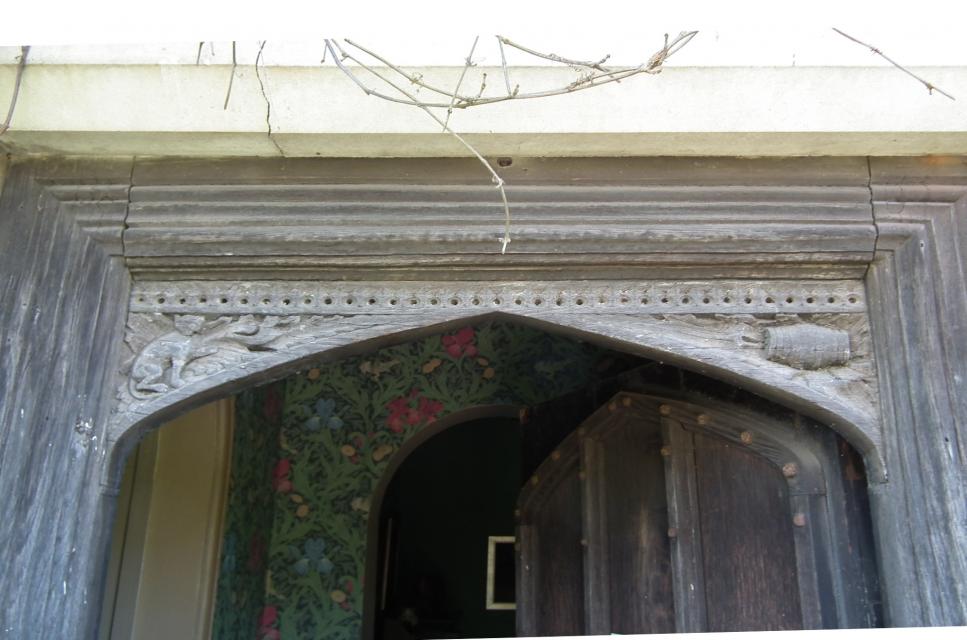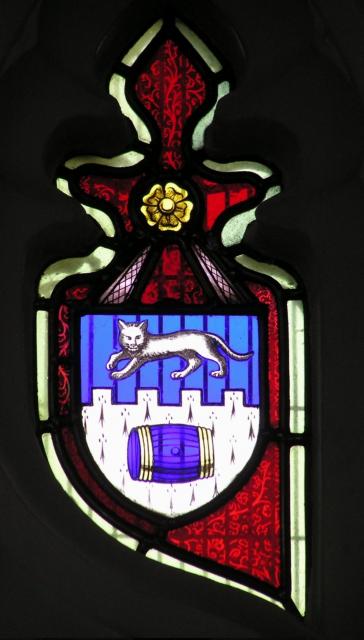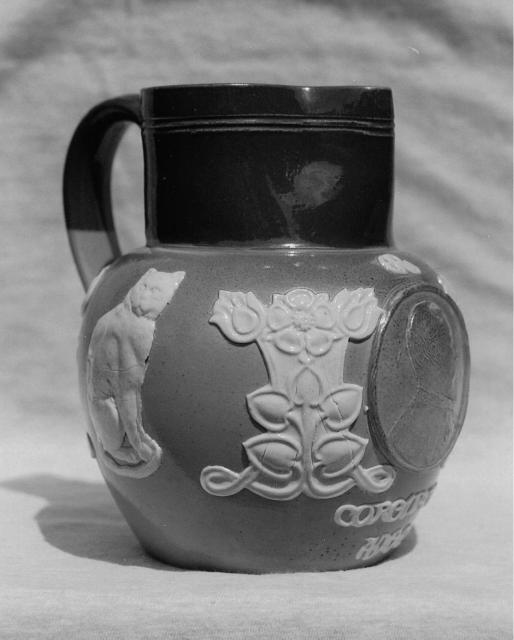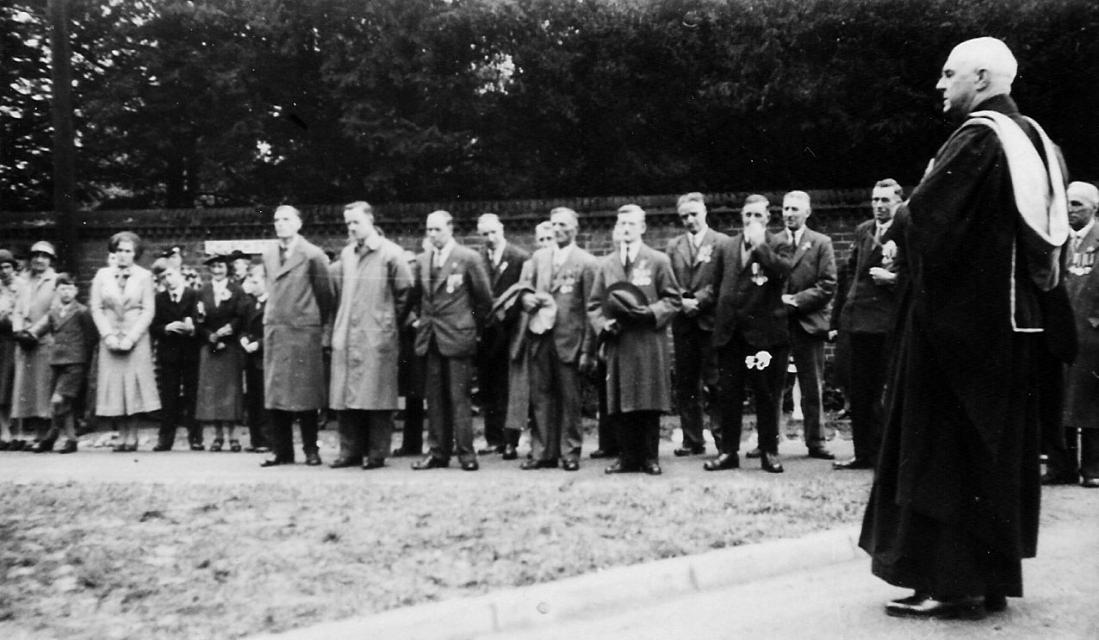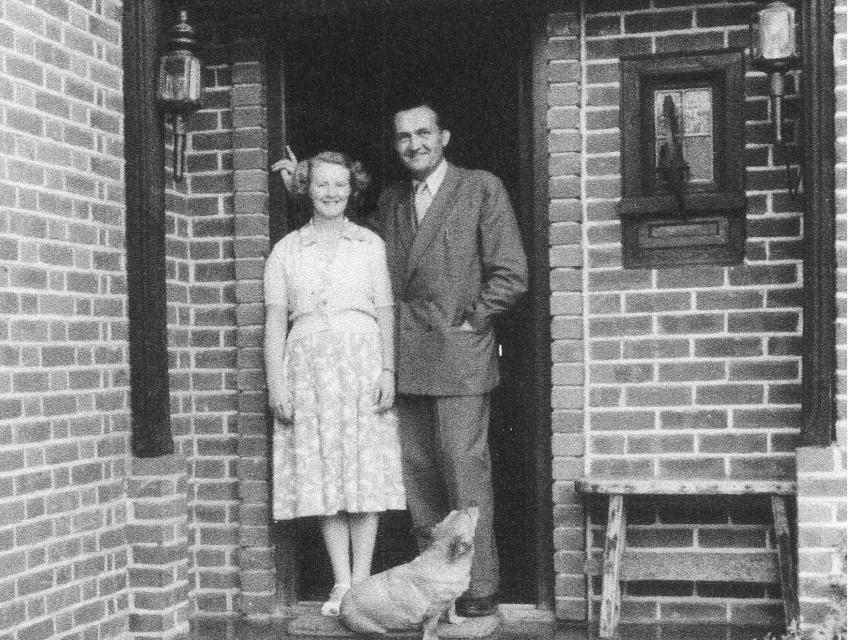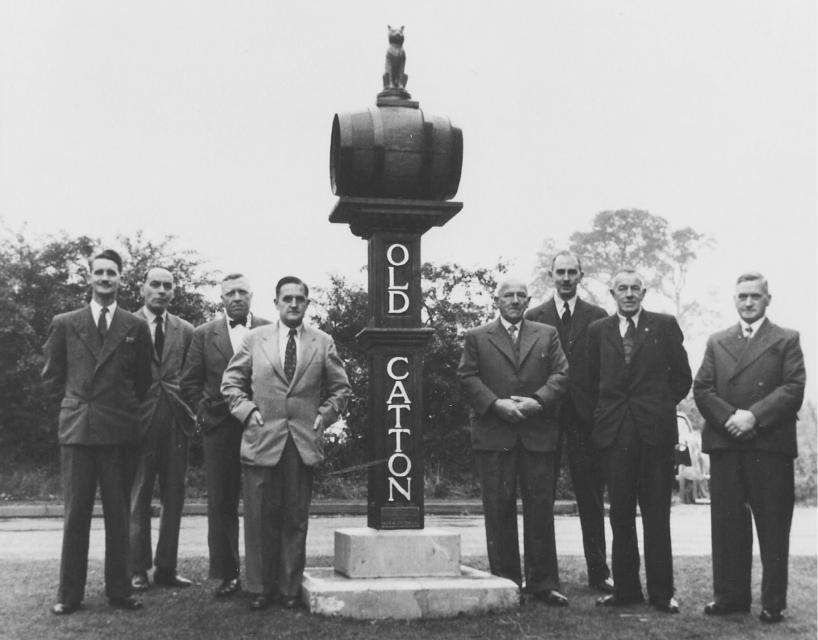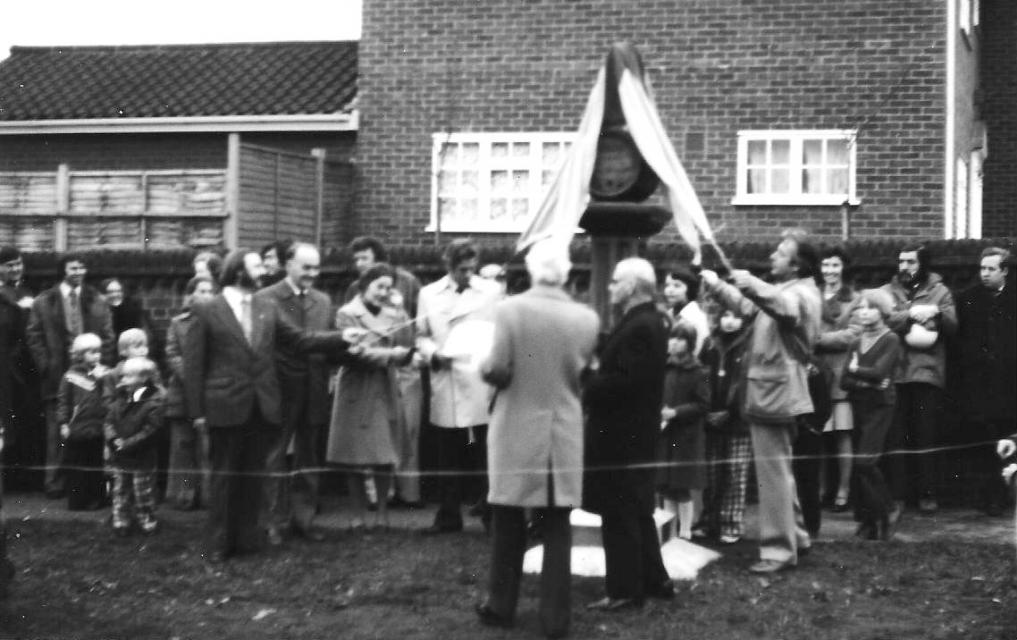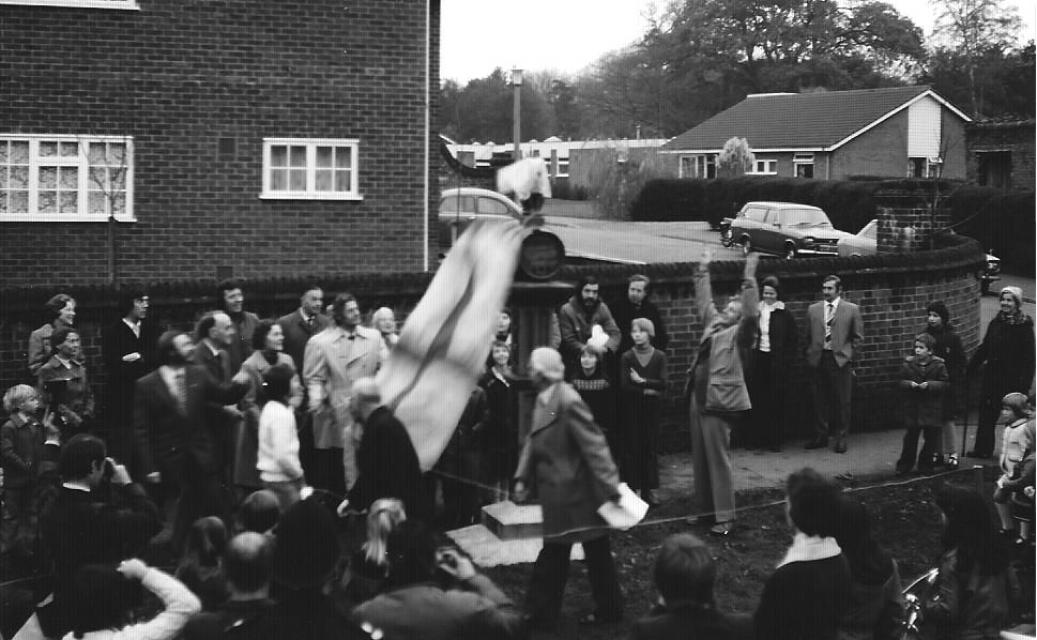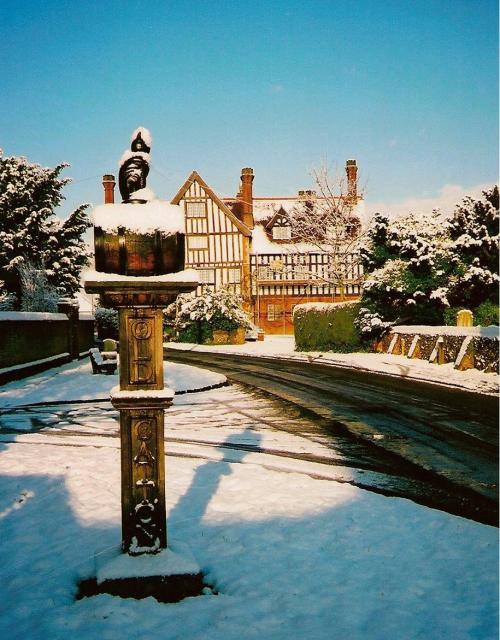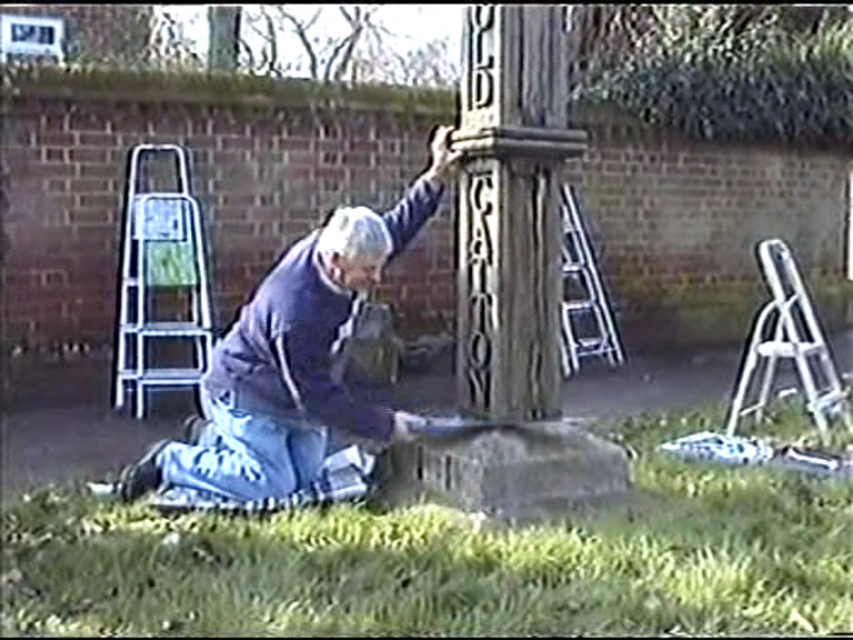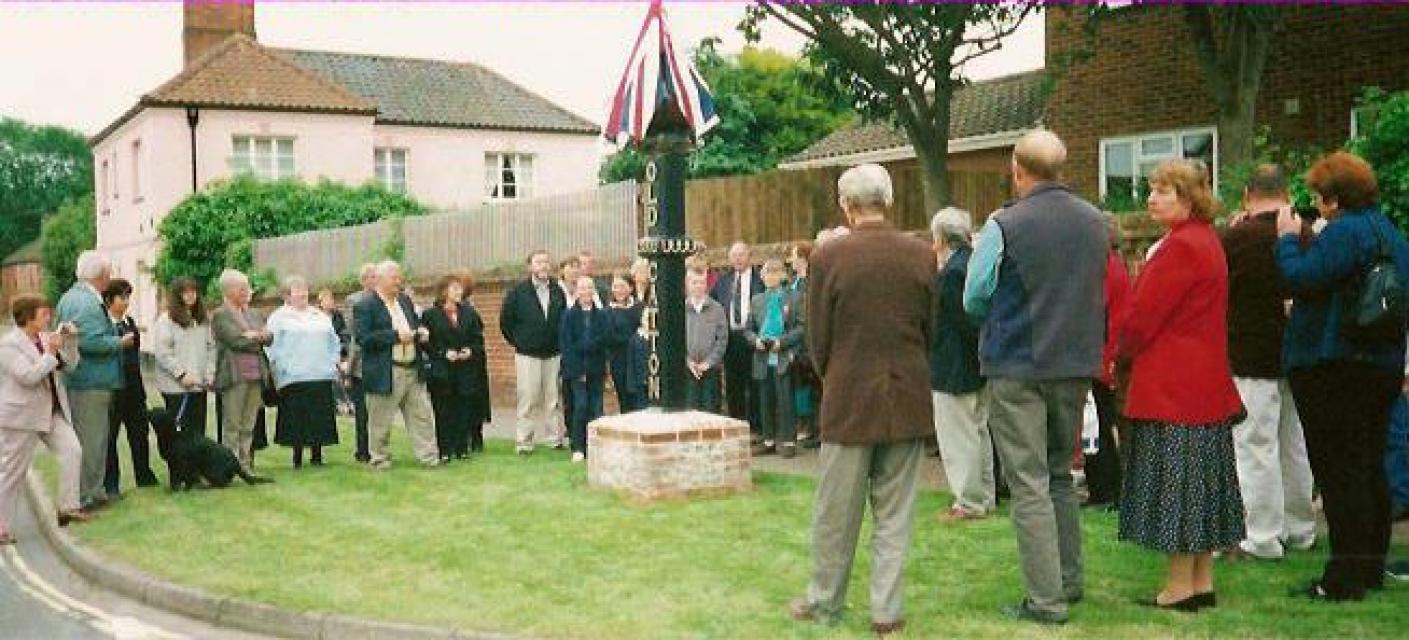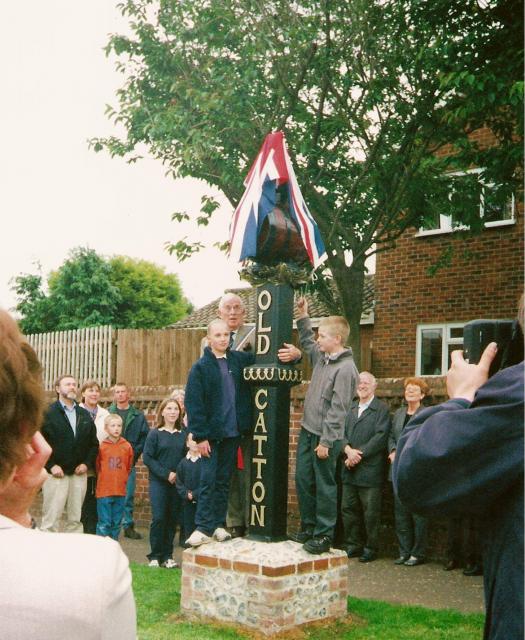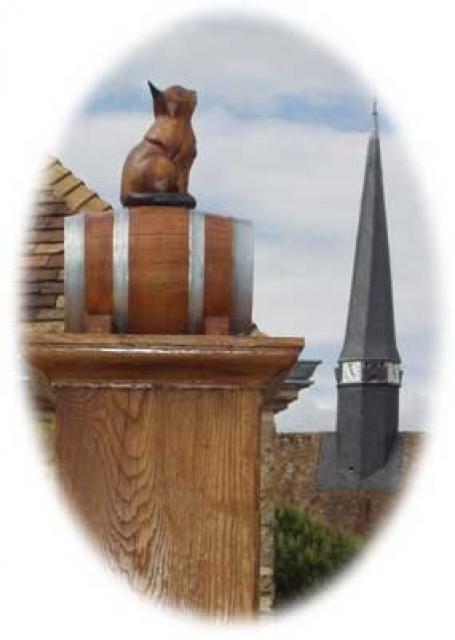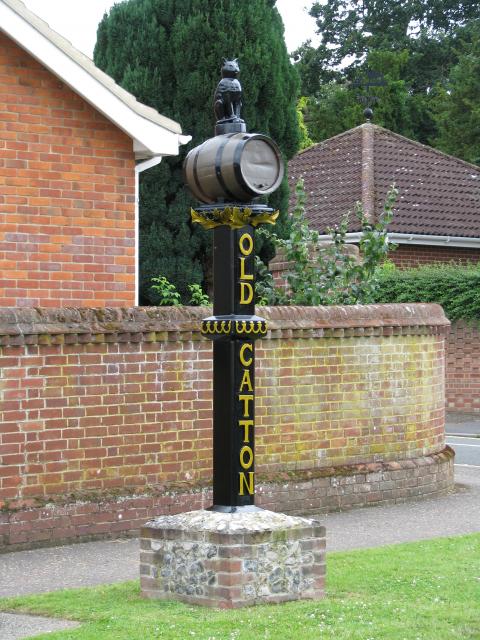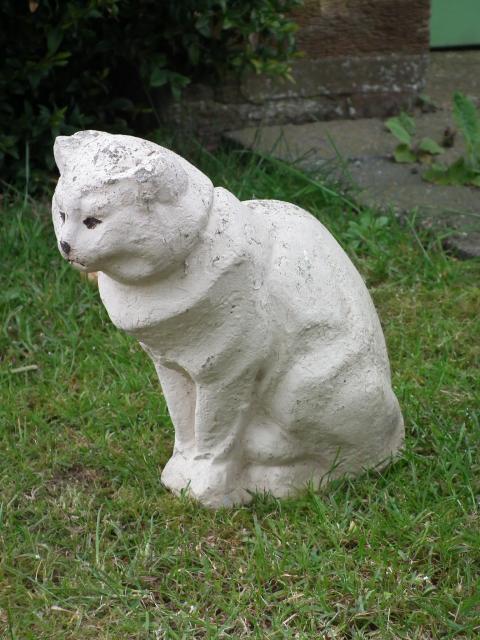Preface
This is an attempt to unravel the mysteries of the village sign with its cat of many lives. It it not altogether clear from this point in history where the cat was at various times, especially during the Second World War, how many of him disappeared not to be seen again, and which other parts of the country (and world) he has seen in his travels. Could he be a relative of Schrodinger's cat?
I have put this together from a variety of Council minutes, press reports, parish talk etc. I gratefully acknowledge the help of Peter Klinge and Melvyn Johnson for photos and information, our publication Old Catton in the Twentieth Century, and the village website oldcatton.com who have supplied photographs sent by former USAF servicemen.
RFJ
THE OLD CATTON VILLAGE SIGN : THE STORY OF THE CAT ON THE BARREL
The Old Catton sign with a cat atop a barrel is a symbol which must be familiar to many people outside the village. It beginnings, however, pre-date the sign by some 400 years.
The rebus of a wild cat on a barrel is first recorded as the sign of Prior Robert Bronde (also known as Robert de Catton), last but one prior of Catton before the dissolution of the monasteries in 1538. Historical sources record that his heraldic arms included “..an ounce or cat of mountain.” and were included in stained glass placed in the windows of St Margaret’s church by Bronde himself. The original Tudor doorway on the east front of the Manor House is surmounted by a carving of a cat and a barrel.
The Cat and Barrel rebus is next found in a beautiful section of stained glass in the south window of St Margaret's church installed in 1850 by its vicar the Revd. Richard Hart.
The most obvious and well known manifestation of the device is found in the cat and tun reliefs carved in the door frame over the south door of the Manor House in Church Street in the 1891. This work is a well-executed copy the Tudor carving over the east door. It has been suggested that William Badcock, the village blacksmith and carpenter was the craftsman on this occasion. However James Minns, a well known Norwich wood carver, often associated by works by Norwich architect Edward Boardman, is more likely to have been responsible: a footnote on plans for Boardman's remodelling of the Manor House in 1891 names the Minns family as carvers.
In 1902, to celebrate the Coronation of King Edward VII, the Buxton family of Catton Hall gave a commemorative mug, made by the famous Doulton pottery, to every household in the village: the jug featured a cat in relief on one side and a barrel on the other. Several are still held in private ownership in the village.
These are all the forerunners of the sign we all know so well. The origins are a happy mix of intent and coincidence. In March 1936 the Parish Council asked parishioners to send in suggestions for ways to commemorate the Coronation of King George VI. None were received immediately. Later that year a Mr Fred Gough, the owner of the Norwich Paper and Cardboard Co. and who lived at Crome House, entered the scene, as recorded in the parish minutes for November 1936:-
“The Chairman read a letter from Mr F Gough who would like to erect a sign representing the “Cat” and the “Tun”on the “Village Green” at the top of Church Street [and St Faiths Road], similar to that erected at Swaffham, to preserve the small island. It was decided to accept Mr Gough’s offer in principle, the Clerk to write and thank Mr Gough. Our two representatives on the St Faiths RDC agreed to bring the matter to the latter body.”
At the same meeting the parish clerk reported that no suggestions had been received as to the commemoration of the forthcoming coronation, and the matter was postponed to early February 1937 to allow time to see what other villages were doing. And so the two interests eventually merged and the sign did, in fact, become a Coronation marker. It was duly unveiled in 1937 by Mr Gough's son John in the presence of the vicar, the Revd McCready, and formally handed over to Mr. Bernard Nicholson, Chairman of Old Catton Parish Council, with a large gathering of crowd of councillors and parishioners standing by. Unfortunately the identity of the designer and maker of the sign are unknown. (but see footnote)
A commercial post-card published in 1938 illustrates the sign perfectly, showing scrolled iron-work under the top pedestal, and a vertical in inscription which read, “G.R.- TO COMMEMORATE THE CORONATION OF KING GEORGE VI ON 18TH MAY 1937”. Neither of these two features appear to have survived beyond the 1940s.
In Oct 1937 it was noted in the minutes that under Section 268 (I) Local Govt. Act 1933 the Parish Council were empowered to have reasonable expenses for the upkeep of the Village Sign presented by Mr F Gough to commemorate the coronation of King George VI and Queen Elizabeth. On 25 April, 1938 the parish council minutes record that Mr Fred Gough was having the sign renovated. No reason is given for remedial work on such a new feature, but the varnish was hardly dry when a remarkable series of adventures was to begin. World War II had intervened and across the nation signposts were taken down to confuse the enemy. In this way the Officer’s Mess at RAF Horsham St Faiths became the home of the sign for the duration of hostilities. The council minutes for August 1940 record:-
“The sign having been removed by request of the local police officer and temporarily placed in front of the Officers' Mess R.A.F. Fifers Lane by request of the C.O. It was resolved on proposition of Mr Sabberton seconded by Mr Booty that the Commanding Officer should give the Council a written receipt for the sign on the understanding that it should be returned in good order to the former site on conclusion of hostilities.”
It is not clear what benefit the minor relocation of the sign would have in deceiving the enemy should they arrive, but in any event it was clearly popular with the RAF as the following letter of 17 August 1940 to the Parish Clerk demonstrates:-
“In reply to your letter dated 10th. August, 1940 I acknowledge that the Village Sign at present erected outside the Officers' Mess is in fact on loan from the Parish.
I would add that we are very pleased indeed to have the loan of it and hope that after the War you may consider giving us permission to erect a copy of it outside the Mess premises. It may interest you to know that we have asked for the name of the Station to be altered to Old Catton.
Yours very truly,
F Knight (Group Captain)"
In the final years of the war American Liberator aircraft were based at the airfield and US servicemen were clearly taken by the 'cute' sign on their doorstep. A photograph which has recently come to light shows Capt. Maurice Speer standing beside the sign in front of the Officers' Mess (recently demolished for the housing development north of Fifers Lane)
Events during the war are shrouded in mystery but rumour has it that the cat took part in a bombing raid over Germany. As the threat of German invasion waned the calls for the sign to be returned to its original home began. The Parish minutes for April 1944 record that Mr Lines proposed that sign be brought back to its old position. On this occasion, however there was no seconder. Then at the Parish Meeting in April 1945 the Clerk was instructed to approach the Air Ministry regarding the restoration sign when fit to do so.
On the 14th June 1945 the RAF responded as follows:-
“Old Catton Village Sign
Receipt is acknowledged of your letter of the 11th inst., regarding the collection of the Old Catton village sign which is at present situated on front of the Officers' Mess.
The Senior Works Officer raises no objection to the removal of the sign, provided no expense is incurred by the Air Ministry, but I regret to inform you that the cat is missing.
The matter has been taken up with the Unit Executive Officer, who assures me that no effort will be spared in endeavouring to trace the cat, and it is hoped that steps already taken will result in its location and return.
This matter is sincerely regretted, both by myself and the Unit.
Yours faithfully
Clerk of Works”
Four days later another letter was received:-
“Old Catton Village Sign
With reference to my letter of the 14th inst., I have pleasure in informing you that the cat has been traced and is now held in safe custody.
I should be glad if your representative would call at this office when he comes to remove the sign from the Officers' Mess; the cat will then be handed over to him.
Yours faithfully
Clerk of Works”
In June 1946 the Council accepted Mr Southgate's tender for re-erection of the sign. Materials were evidently difficult to obtain in the post-war economy, but the work was finally completed by the end of the year, and the sign stood again at its original home. There then began a long period of mixed fortunes.
In February 1949 the parish clerk reported the removal of the cat by RAF auxiliary merrymakers. Two months later, thanks to the local and RAF Constabulary, it was returned from Stockton-on Tees. The re-installation was undertaken by an RAF NCO but the sign was cleaned up at Parish expense. A charge of 25 shillings was made and councillor Mr English had taken steps to obtain restitution from the CO of the auxiliary unit at Stockton on Tees. Mr English undertook to express the appreciation of the Parish Council to the Station Commander at Horsham St Faiths.
The cat has not been forgotten in the USA as village resident Colin Green discovered in the early 1990s. On a visit to the Queen Mary at her final resting place in Long Beach, he found a photograph and mention of St Faiths displayed on the wall of one of the great liner's public corridors.
It was reported in September 1952 that the cat had again vanished without trace. Fishponds, Bristol was mentioned as a possible fruitful ground of enquiry and Mr English promised to to convey this information to the police. However our Chairman received an offer from Mr Wolfgang Klinge, who had lately returned to his native Denmark, to replace the the cat as a recognition of happy years spent in Old Catton, while working for Bush Builders at Hellesdon.
In November 1952 Mr English reported that the offer by Mr Klinge had been enthusiastically accepted on behalf of the Council. The Clerk was instructed to write to Mr Klinge expressing the warm appreciation of the Council.
Throughout the following year there are various reports to the Parish Council which indicate that there were frustrating delays in the making of a new cat. Mr Klinge was very disappointed that nothing had been done especially as he had paid for the work before leaving Norwich..
In February 1954 Councillor English reported that Mr Klinge proposed to get the cat made in Denmark. Pending its arrival the Clerk was instructed to investigate the cost of a plaque with the words 'Erected by Fred Gough Esq.1937* - Restored by WHE Klinge Esq 1953'. The Clerk undertook to supply a paragraph to the Press and Parish Magazine when the job was completed.
[* - the plaque installed noted the gift of Fred Gough in 1936, perhaps correctly reflecting this year as the birth of the idea.]
In June 1954, pending its arrival, RAF personnel were seen trying (unsuccessfully) to remove the barrel. The new cat was finally posted to England and erected in September 1954.
In a very interesting development in November 1954 the Parish Clerk received a letter from the Commanding Officer, RAF Horsham St Faiths, with intelligence that a cat might be found adorning a street sign in Chicago. A letter to the mayor of Chicago produced an inscrutable reply thanking the village for their hospitality to the USAF during the war, but made no mention of the sign. The parish minutes for April 1955 note a suggestion of a sighting in Orkney or Shetland.
Back in Old Catton the life of Klinge's cat was very short-lived for, on 19 April 1955, The Eastern Evening News reported that both the cat and barrel had been wrenched off the post the previous night. Melvyn Johnson reports that the barrel was found on farmland, now Ives Road, next to the garden of the vicarage, which was then at the junction of Fifer's Lane with St Faiths Road - there was no sign of the cat. A further cat was generously donated by Wolfgang Klinge, and the Parish minutes for January 1956 duly record the arrival of a new teak cat from Denmark.
The sign again suffered damage in 1971: on Sunday 12 June at 1.30 a.m. two men were seen trying to remove the cat; they were seen off but not before leaving three saw cuts. The barrel was damaged beyond repair and a new one had to be made.
A major change took place in 1972 when, for traffic reasons, the whole sign was moved from the busy Church Street junction. It had originally been intended to place it by the new school extension in Church Street, but the wide grass verge created by the development of Parkside Drive was finally chosen and the sign became a dramatic village centre feature opposite the church. In June 1976, vandals struck again when the whole sign was laid flat. This prompted a complete renovation which was carried out in the workshops of Johnsons Joinery of Hellesdon at their expense, and unveiled by [Yorkshire born] parish council chairman Bill Catton at a ceremony on 13 November 1976. A wooden shield presented to Johnsons employees records their part in the restoration.
The next quarter century seems to have been incident free, but by the end of the 20th century the timber post was deemed by the Parish Council to have decayed beyond the point of repair and a new steel upright was commissioned.
In March 2001 the wooden post was therefore sawn down and in due course, after further renovation of the cat and barrel by Melvyn Johnson (who worked on the earlier restoration in Hellesdon as a young man), the new upright was put in place. By curious coincidence Drayton resident Peter Klinge, the son of Wolfgang, happened to drive past as the sign was being dismantled and stopped to see and reminisce. At a formal ceremony on 7 May 2001 the new sign was unveiled by Peter’s son Martin, the grandson of Wolfgang Klinge, along with Lucy Dingle.
In another nice touch a model of the sign was made from the old upright by Barry Leggett and presented to the Mayor of Lavare during the visit of the French Exchange to our twinned village in 2003. Another part was used to make a gavel for Old Catton Society. The remaining half of the decaying wooden upright was saved by Barry Leggett where it, with a freshly carved small cat and barrel, can be found on the wall beneath his car port in Garrick Green.
By an interesting development our website administrators recently visited Zell-am-Zee in the Moselle valley and were amazed to discover a fountain in the town square with a large cat and barrel statue at its centre, and brought back wine bottles with labels illustrating the feature.
In retrospect it is not entirely clear how many cats there have been, but It seems that the present incarnation is probably the fourth, sitting on what we know to be barrel number two.
In July 2009, being in need of further renovation, the sign was repainted. During the course of the work the cat fell sideways, no doubt due to decay. It was removed, renovated and replaced.
More recently, on Sunday 26 August 2012, Becky Betts and the the BBC Radio Norfolk Treasure Quest team arrived to find a clue secreted by the Society archivist in the leaf scroll work around the top of the column. The easily solved clue bringing the radio car to Church Street was:
“The rugby man who has aged a bit is changed from being on standby. The signs are they are not scraping it, not whisky in, but something galore over!”
Unfortunately history repeated itself on 11 October 2012, when the cat and barrel were found missing. It was soon discovered, however, that it had been briefly removed by the Parish Council for repair. By 2017 the barrel had decayed beyond repair and a new one was made and installed by Barry Leggett and his son Graeme.
So, some 75 years on, the cat of many lives still stands and watches the villagers go about their business, often seen sporting a Father Christmas bobble hat during the festive season.
Footnote
In early 2016 I received an email from John Hennings of Droitwich. He said “It is told to me that the sign was designed by Bernard Nicholson (my Grandfather) he was the Architect for Bullards Brewery and I was always told that his idea was to place a cat onto a model of a "tun". I have, what I was told as being the original Alabaster cat used to model the carved version.”
It was immediately obvious that his grandfather was none other than the Catton Parish Council Chairman who was present at the unveiling of the sign in 1937. One mystery was solved. To add to the delight was that John had in his possession an alabaster cat which was said to be the model for the cat on the barrel. John duly arrived in the village with the model and It was a delight to introduce it to the present one and be able to photograph them together. John also able to visit the grave of the grandfather he had never known in St Margaret's churchyard.
RJ

